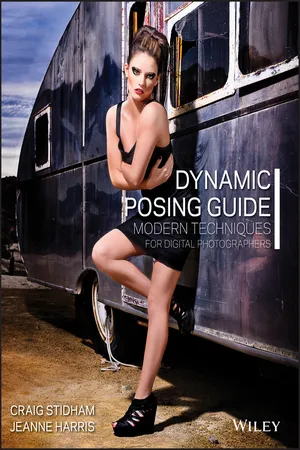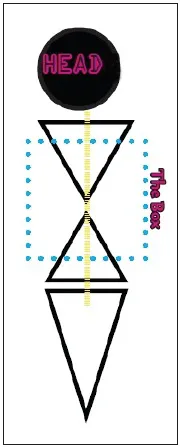
eBook - ePub
Dynamic Posing Guide
Modern Techniques for Digital Photographers
This is a test
- English
- ePUB (mobile friendly)
- Available on iOS & Android
eBook - ePub
Book details
Book preview
Table of contents
Citations
About This Book
Tips, techniques, and inspiration for creating perfect poses
Effectively posing the human body is a challenge for nearly every photographer, from amateur to professional. Understanding how a model's pose, body language, and posture affect a photograph is crucial to success. Author and professional fashion photographer Craig Stidham shows you how to guide a subject's personality through body language, with hundreds of examples and suggestions.
- Answers critical questions such as: how can a photographer avoid having the subject look awkward? How does one direct both experienced and inexperienced models?
- Shares helpful posing tips and techniques for posing models in new modern and fashion-forward ways
- Suggests ways to make strategic edits in post-production to fix common posing mistakes
- Offers hundreds of examples of strong and stunning posing
Dynamic Posing Guide teaches you the skills you need to identify strong modern posing techniques as you strengthen your photographic skills.
Frequently asked questions
At the moment all of our mobile-responsive ePub books are available to download via the app. Most of our PDFs are also available to download and we're working on making the final remaining ones downloadable now. Learn more here.
Both plans give you full access to the library and all of Perlego’s features. The only differences are the price and subscription period: With the annual plan you’ll save around 30% compared to 12 months on the monthly plan.
We are an online textbook subscription service, where you can get access to an entire online library for less than the price of a single book per month. With over 1 million books across 1000+ topics, we’ve got you covered! Learn more here.
Look out for the read-aloud symbol on your next book to see if you can listen to it. The read-aloud tool reads text aloud for you, highlighting the text as it is being read. You can pause it, speed it up and slow it down. Learn more here.
Yes, you can access Dynamic Posing Guide by Craig Stidham, Jeanne Harris in PDF and/or ePUB format, as well as other popular books in Mezzi di comunicazione e arti performative & Media digitali. We have over one million books available in our catalogue for you to explore.
Information

CHAPTER 1: Breaking Down the Human Figure
Let’s look at the human body and break it down. At first glance, though we might each focus on different aspects, the average person tends to look at the body as one unit. But as photographers and artists, it’s essential for us to concentrate on the components that make, move, and create form within the human body. You need to think of yourself more as a sculptor or architect. From that perspective, for the purposes of posing, the primary parts of the human body on which you need to focus are the skeletal and muscular system. You must understand these elements and how they work or you will never master your craft. After understanding how the skeletal and muscular systems work together, next you need to focus on the joints and weight to learn how they work in conjunction with these two primary elements.
And here you thought that anatomy class would have nothing to do with photography!
You want to pose and move your models in specific ways to portray a certain attitude. To achieve this, you have to take into account that you are operating three major body components: bones, muscles, and joints. Posing isn’t just a about moving an arm or leg here or there—you need to understand why you want to move that arm or leg.
By following some fundamental rules of the human figure, in this chapter I will explain how and why we move specific parts of the body in particular ways by activating or deactivating certain muscles, all toward the goal of either centering the weight or pushing it away.
The Human Figure as a Diagram
Because photography is a two-dimensional medium, one fundamental rule would seem to be that the closer an object is to the lens, the bigger it appears, right? Thus, the logic then follows that the farther away from the lens the object is, the smaller it appears.
A general rule of thumb, as shown in Figure 1.1, is you want to present men most often facing straight to the camera, which gives the illusion of being bigger, broader, and more statuesque. Whereas with women, you want to drop all the weight and make them look thin like a pencil. You achieve this by positioning their bodies at an angle and pushing their weight away from the camera. You don’t want to capture images that make your female models look big or heavy, so you want to avoid posing them straight to the camera. I’ll show you how to never hear “I look fat in that photo” again.


Figure 1.1
After years of teaching posing, I had an epiphany and came up with the diagrams shown in Figure 1.2. These diagrams are the simplest way to dissect the human body and use it for your modeling purposes. The block circle represents the head; the first upside-down diamond triangle represents the shoulders to the belly button; the diamond below that represents the belly button to the waist; and the elongated triangle represents the waist down to the feet.


Figure 1.2
Notice the yellow line drawn directly down the middle of all three triangles. That line represents the spinal column. Next, locate the dotted-blue box. This represents the chest area, which includes everything from the clavicle bone to the belly button—an area I refer to as The Box. I always tell people, “rule number one is Don’t block The Box.” What that means is, do not put the model’s arms or hands inside that region. It adds weight and usually looks awkward or just plain bad. Of course, there are exceptions, which I’ll go over later, but when starting out, keep this rule in mind.
With the yellow line re...
Table of contents
- Introduction
- CHAPTER 1: Breaking Down the Human Figure
- CHAPTER 2: Rules of Posing
- CHAPTER 3: Seated Posing
- CHAPTER 5: Camera Angles
- CHAPTER 6: Equipment
- CHAPTER 7: Breaking the Rules